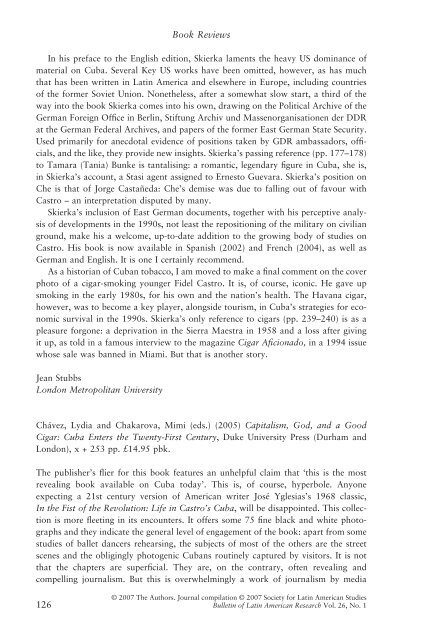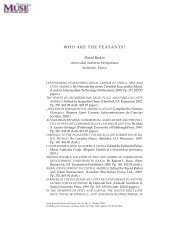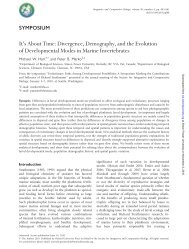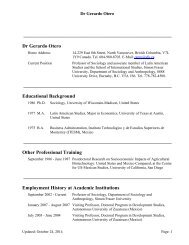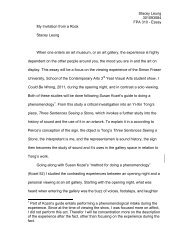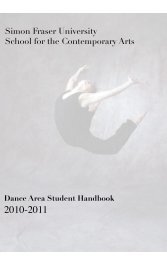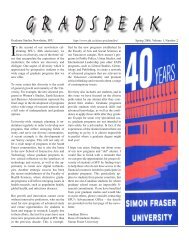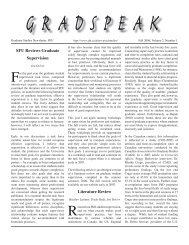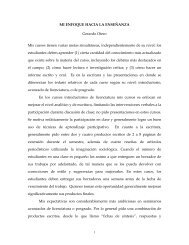Review of Mexico in Transition by Byron Crites
Review of Mexico in Transition by Byron Crites
Review of Mexico in Transition by Byron Crites
- TAGS
- transition
- byron
- crites
- cgi.sfu.ca
You also want an ePaper? Increase the reach of your titles
YUMPU automatically turns print PDFs into web optimized ePapers that Google loves.
Book <strong>Review</strong>s<br />
In his preface to the English edition, Skierka laments the heavy US dom<strong>in</strong>ance <strong>of</strong><br />
material on Cuba. Several Key US works have been omitted, however, as has much<br />
that has been written <strong>in</strong> Lat<strong>in</strong> America and elsewhere <strong>in</strong> Europe, <strong>in</strong>clud<strong>in</strong>g countries<br />
<strong>of</strong> the former Soviet Union. Nonetheless, after a somewhat slow start, a third <strong>of</strong> the<br />
way <strong>in</strong>to the book Skierka comes <strong>in</strong>to his own, draw<strong>in</strong>g on the Political Archive <strong>of</strong> the<br />
German Foreign Offi ce <strong>in</strong> Berl<strong>in</strong>, Stiftung Archiv und Massenorganisationen der DDR<br />
at the German Federal Archives, and papers <strong>of</strong> the former East German State Security.<br />
Used primarily for anecdotal evidence <strong>of</strong> positions taken <strong>by</strong> GDR ambassadors, <strong>of</strong>fi -<br />
cials, and the like, they provide new <strong>in</strong>sights. Skierka ’ s pass<strong>in</strong>g reference (pp. 177 – 178)<br />
to Tamara (Tania) Bunke is tantalis<strong>in</strong>g: a romantic, legendary fi gure <strong>in</strong> Cuba, she is,<br />
<strong>in</strong> Skierka ’ s account, a Stasi agent assigned to Ernesto Guevara. Skierka ’ s position on<br />
Che is that <strong>of</strong> Jorge Castañeda: Che ’ s demise was due to fall<strong>in</strong>g out <strong>of</strong> favour with<br />
Castro – an <strong>in</strong>terpretation disputed <strong>by</strong> many.<br />
Skierka ’ s <strong>in</strong>clusion <strong>of</strong> East German documents, together with his perceptive analysis<br />
<strong>of</strong> developments <strong>in</strong> the 1990s, not least the reposition<strong>in</strong>g <strong>of</strong> the military on civilian<br />
ground, make his a welcome, up-to-date addition to the grow<strong>in</strong>g body <strong>of</strong> studies on<br />
Castro. His book is now available <strong>in</strong> Spanish (2002) and French (2004), as well as<br />
German and English. It is one I certa<strong>in</strong>ly recommend.<br />
As a historian <strong>of</strong> Cuban tobacco, I am moved to make a fi nal comment on the cover<br />
photo <strong>of</strong> a cigar-smok<strong>in</strong>g younger Fidel Castro. It is, <strong>of</strong> course, iconic. He gave up<br />
smok<strong>in</strong>g <strong>in</strong> the early 1980s, for his own and the nation ’ s health. The Havana cigar,<br />
however, was to become a key player, alongside tourism, <strong>in</strong> Cuba ’ s strategies for economic<br />
survival <strong>in</strong> the 1990s. Skierka ’ s only reference to cigars (pp. 239 – 240) is as a<br />
pleasure forgone: a deprivation <strong>in</strong> the Sierra Maestra <strong>in</strong> 1958 and a loss after giv<strong>in</strong>g<br />
it up, as told <strong>in</strong> a famous <strong>in</strong>terview to the magaz<strong>in</strong>e Cigar Afi cionado, <strong>in</strong> a 1994 issue<br />
whose sale was banned <strong>in</strong> Miami. But that is another story.<br />
Jean Stubbs<br />
London Metropolitan University<br />
Chávez, Lydia and Chakarova, Mimi (eds.) (2005) Capitalism, God, and a Good<br />
Cigar: Cuba Enters the Twenty-First Century , Duke University Press (Durham and<br />
London), x + 253 pp. £14.95 pbk.<br />
The publisher ’ s fl ier for this book features an unhelpful claim that ‘ this is the most<br />
reveal<strong>in</strong>g book available on Cuba today ’ . This is, <strong>of</strong> course, hyperbole. Anyone<br />
expect<strong>in</strong>g a 21st century version <strong>of</strong> American writer José Yglesias ’ s 1968 classic,<br />
In the Fist <strong>of</strong> the Revolution: Life <strong>in</strong> Castro ’ s Cuba , will be disappo<strong>in</strong>ted. This collection<br />
is more fl eet<strong>in</strong>g <strong>in</strong> its encounters. It <strong>of</strong>fers some 75 fi ne black and white photographs<br />
and they <strong>in</strong>dicate the general level <strong>of</strong> engagement <strong>of</strong> the book: apart from some<br />
studies <strong>of</strong> ballet dancers rehears<strong>in</strong>g, the subjects <strong>of</strong> most <strong>of</strong> the others are the street<br />
scenes and the oblig<strong>in</strong>gly photogenic Cubans rout<strong>in</strong>ely captured <strong>by</strong> visitors. It is not<br />
that the chapters are superfi cial. They are, on the contrary, <strong>of</strong>ten reveal<strong>in</strong>g and<br />
compell<strong>in</strong>g journalism. But this is overwhelm<strong>in</strong>gly a work <strong>of</strong> journalism <strong>by</strong> media<br />
© 2007 The Authors. Journal compilation © 2007 Society for Lat<strong>in</strong> American Studies<br />
126 Bullet<strong>in</strong> <strong>of</strong> Lat<strong>in</strong> American Research Vol. 26, No. 1


